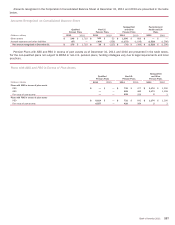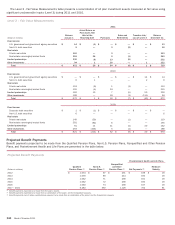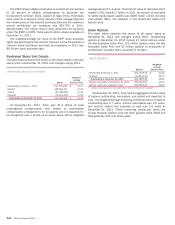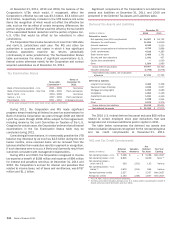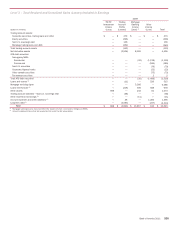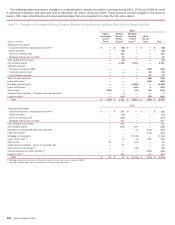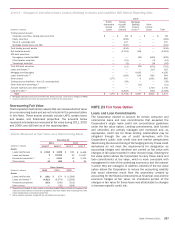Bank of America 2011 Annual Report Download - page 249
Download and view the complete annual report
Please find page 249 of the 2011 Bank of America annual report below. You can navigate through the pages in the report by either clicking on the pages listed below, or by using the keyword search tool below to find specific information within the annual report.Bank of America 2011 247
The Corporation concluded that no valuation allowance is
necessary to reduce the U.K. NOLs, U.S. NOL and general business
credit carryforwards since estimated future taxable income will be
sufficient to utilize these assets prior to their expiration. During
2011, the valuation allowance decreased due to the utilization of
the remaining acquired capital loss carryforward and increased
primarily against net operating loss carryforwards in non-U.S. and
state jurisdictions.
At December 31, 2011 and 2010, U.S. federal income taxes
had not been provided on $18.5 billion and $17.9 billion of
undistributed earnings of non-U.S. subsidiaries earned prior to
1987 and after 1997 that have been reinvested for an indefinite
period of time. If the earnings were distributed, an additional $2.5
billion and $2.6 billion of tax expense, net of credits for non-U.S.
taxes paid on such earnings and for the related non-U.S.
withholding taxes, would have resulted as of December 31, 2011
and 2010.
NOTE 22 Fair Value Measurements
Under applicable accounting guidance, fair value is defined as the
exchange price that would be received for an asset or paid to
transfer a liability (an exit price) in the principal or most
advantageous market for the asset or liability in an orderly
transaction between market participants on the measurement
date. The Corporation determines the fair values of its financial
instruments based on the fair value hierarchy established under
applicable accounting guidance which requires an entity to
maximize the use of observable inputs and minimize the use of
unobservable inputs when measuring fair value. There are three
levels of inputs used to measure fair value. For more information
regarding the fair value hierarchy and how the Corporation
measures fair value, see Note 1 – Summary of Significant
Accounting Principles. The Corporation accounts for certain
financial instruments under the fair value option. For more
information, see Note 23 – Fair Value Option.
Level 1, 2 and 3 Valuation Techniques
Financial instruments are considered Level 1 when the valuation
is based on quoted prices in active markets for identical assets
or liabilities. Level 2 financial instruments are valued using quoted
prices for similar assets or liabilities, quoted prices in markets
that are not active, or models using inputs that are observable or
can be corroborated by observable market data for substantially
the full term of the assets or liabilities. Financial instruments are
considered Level 3 when their values are determined using pricing
models, discounted cash flow methodologies or similar
techniques, and at least one significant model assumption or input
is unobservable and when determination of the fair value requires
significant management judgment or estimation.
Trading Account Assets and Liabilities and Available-for-
Sale Debt Securities
The fair values of trading account assets and liabilities are primarily
based on actively traded markets where prices are based on either
direct market quotes or observed transactions. The fair values of
AFS debt securities are generally based on quoted market prices
or market prices for similar assets. Liquidity is a significant factor
in the determination of the fair values of trading account assets
and liabilities and AFS debt securities. Market price quotes may
not be readily available for some positions, or positions within a
market sector where trading activity has slowed significantly or
ceased. Some of these instruments are valued using a discounted
cash flow model, which estimates the fair value of the securities
using internal credit risk, interest rate and prepayment risk models
that incorporate management’s best estimate of current key
assumptions such as default rates, loss severity and prepayment
rates. Principal and interest cash flows are discounted using an
observable discount rate for similar instruments with adjustments
that management believes a market participant would consider in
determining fair value for the specific security. Other instruments
are valued using a net asset value approach which considers the
value of the underlying securities. Underlying assets are valued
using external pricing services, where available, or matrix pricing
based on the vintages and ratings. Situations of illiquidity generally
are triggered by the market’s perception of credit uncertainty
regarding a single company or a specific market sector. In these
instances, fair value is determined based on limited available
market information and other factors, principally from reviewing
the issuer’s financial statements and changes in credit ratings
made by one or more rating agencies.
Derivative Assets and Liabilities
The fair values of derivative assets and liabilities traded in the
OTC market are determined using quantitative models that utilize
multiple market inputs including interest rates, prices and indices
to generate continuous yield or pricing curves and volatility factors
to value the position. The majority of market inputs are actively
quoted and can be validated through external sources, including
brokers, market transactions and third-party pricing services.
When third-party pricing services are used, the methods and
assumptions used are reviewed by the Corporation. Estimation
risk is greater for derivative asset and liability positions that are
either option-based or have longer maturity dates where
observable market inputs are less readily available, or are
unobservable, in which case, quantitative-based extrapolations of
rate, price or index scenarios are used in determining fair values.
The fair values of derivative assets and liabilities include
adjustments for market liquidity, counterparty credit quality and
other instrument-specific factors, where appropriate. In addition,
the Corporation incorporates within its fair value measurements
of OTC derivatives a valuation adjustment to reflect the credit risk
associated with the net position. Positions are netted by
counterparty, and fair value for net long exposures is adjusted for
counterparty credit risk while the fair value for net short exposures
is adjusted for the Corporation’s own credit risk. An estimate of
severity of loss is also used in the determination of fair value,
primarily based on market data.
Loans and Loan Commitments
The fair values of loans and loan commitments are based on
market prices, where available, or discounted cash flow analyses
using market-based credit spreads of comparable debt
instruments or credit derivatives of the specific borrower or
comparable borrowers. Results of discounted cash flow
calculations may be adjusted, as appropriate, to reflect other
market conditions or the perceived credit risk of the borrower.


